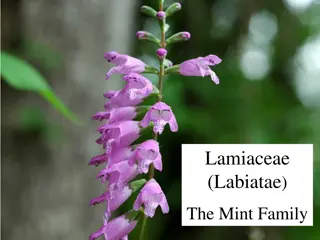Exploring the Malvaceae Family: Characteristics, Recognition, and Economic Importance
The Malvaceae family, also known as the Mallow family, consists of herbs and shrubs with distinct traits like alternate leaves, stellate hairs, radially symmetrical flowers with separate petals, and monadelphous stamens. With a worldwide distribution and diverse species, this plant family holds economic significance through fibers like cotton, food sources such as okra and marshmallow, and ornamental plants like Hibiscus and hollyhock. Recent DNA studies propose expanding Malvaceae to include related families like Tiliaceae, Sterculiaceae, and Bombacaceae.
Download Presentation

Please find below an Image/Link to download the presentation.
The content on the website is provided AS IS for your information and personal use only. It may not be sold, licensed, or shared on other websites without obtaining consent from the author. Download presentation by click this link. If you encounter any issues during the download, it is possible that the publisher has removed the file from their server.
E N D
Presentation Transcript
Malvaceae The Mallow Family
MALVACEAE Mallow Family Ca3-5 Co5 A G5-8 85 genera/1500 species Distribution worldwide; center of diversity is in the American tropics
Recognition Characters: Herbs and shrubs with alternate leaves Leaves palmately lobed and veined Indument of stellate hairs
Flowers radially symmetrical, perfect Corolla of 5 separate petals
Calyx of 3-5 sepals, these fused at the base and sometimes subtended by an epicalyx
stamens monadelphous
Cheeses Musk mallow (Malva moschata) (Malva neglecta)
Economic importance: Fiber: Cotton (Gossypium hirsutum) okra Food: Okra (Hibiscus esculentus), marshmallow (Althaea officinalis) Ornamentals: Hibiscus, hollyhock (Althaea)
Recent evidence from DNA sequence studies suggests that the Malvaceae should be expanded to include the basswood family (Tiliaceae), the cacao family (Sterculiaceae), and the baobab family (Bombacaceae).

























